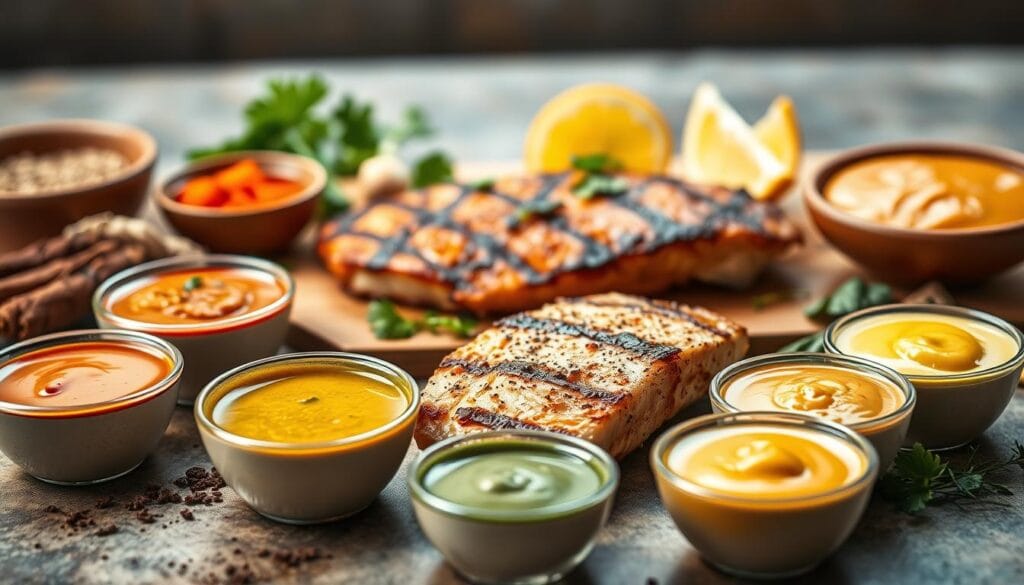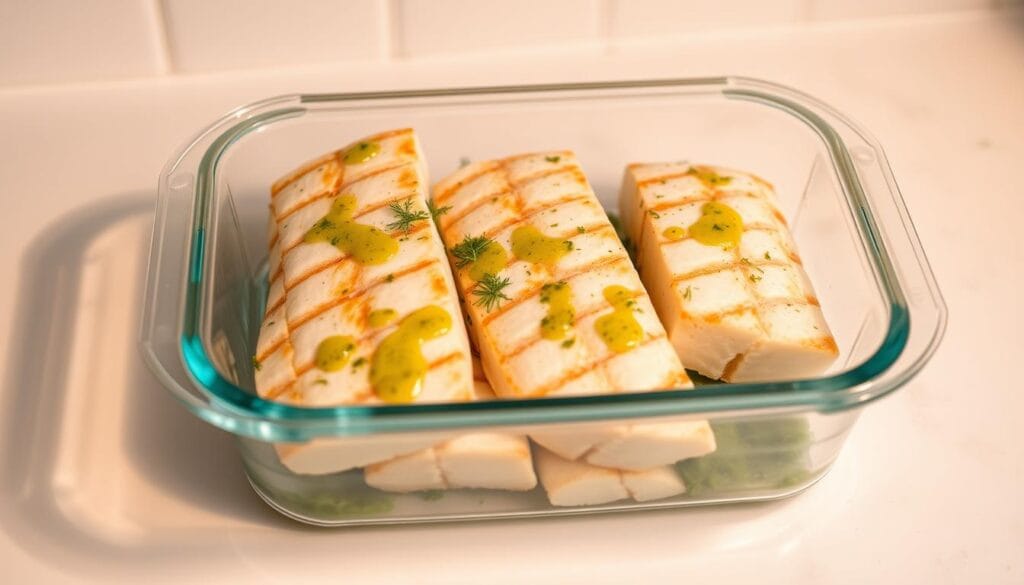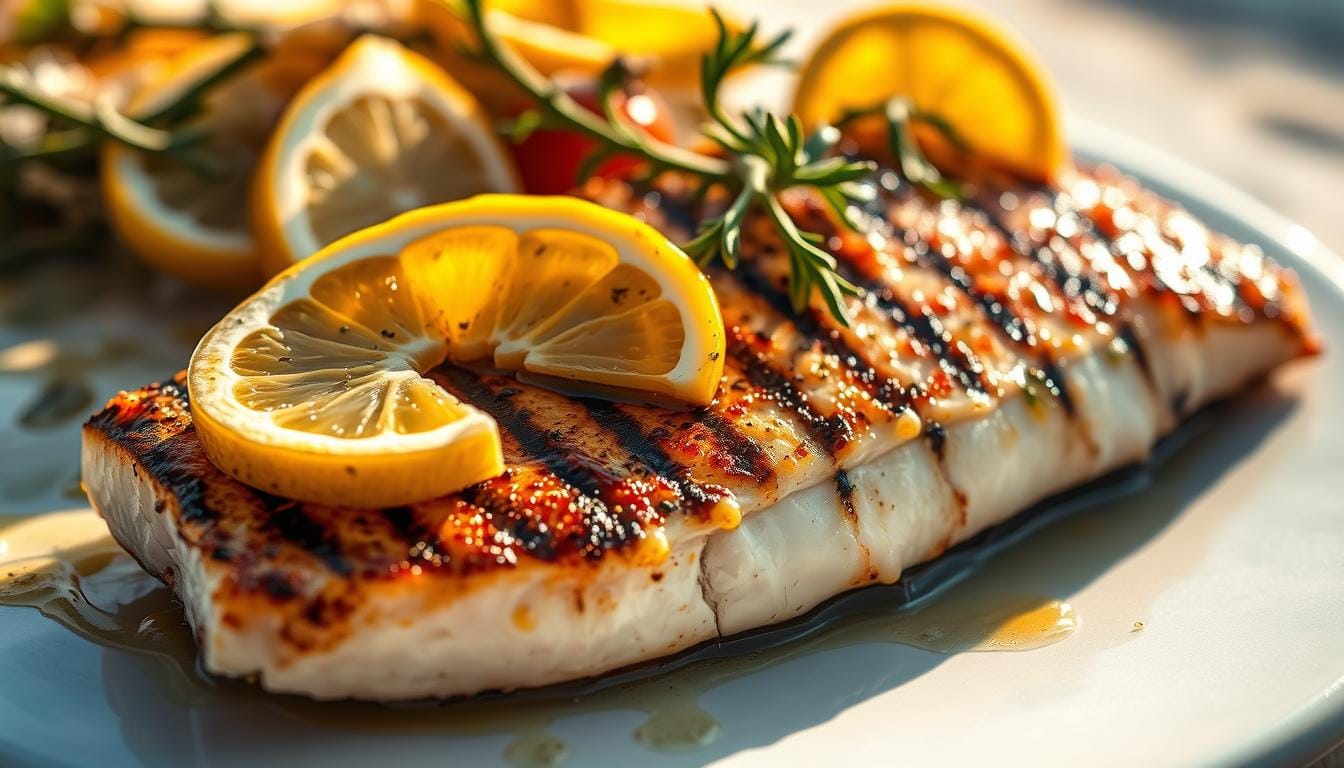Summer evenings are perfect for backyard grilling and trying new seafood recipes. The delicious mahi mahi is my favorite fish for making memorable meals. It’s a mix of nutrition and amazing flavor. This grilled mahi mahi recipe will turn your dinner into a fun adventure.
Table of Contents
Imagine a grilled fish that’s tender, full of nutrients, and tastes like the ocean. Mahi mahi gives you a healthy and satisfying dining experience. It’s a lean protein with lots of nutrients, great for anyone looking for a tasty meal that’s good for you.
Cooking grilled mahi mahi is more than just making food. It’s about enjoying fresh, quality ingredients. With simple steps and little prep, you can make a dish as good as a restaurant’s in your own kitchen.
Key Takeaways
- Mahi mahi is a lean protein source packed with essential nutrients
- Grilling enhances the natural flavors of the fish
- Easy to prepare with minimal cooking skills
- Versatile recipe that works for multiple dietary preferences
- Nutrient-dense meal supporting overall health
Understanding Mahi Mahi: A Premium Seafood Choice
Mahi mahi is a tasty and healthy choice for those looking for easy grilled fish recipes. It’s a vibrant fish that makes cooking a healthy seafood dish simple and flavorful.
Exploring mahi mahi’s unique qualities can change your cooking game. It has a firm texture and a mild taste. This makes it perfect for many cooking methods.
Nutritional Powerhouse
Mahi mahi is packed with nutrients, making it great for those who care about their health. It’s full of protein and important nutrients:
- High-quality lean protein
- Rich in omega-3 fatty acids
- Low in calories
- Excellent source of vitamin B12
Fresh vs. Frozen Selection
When buying mahi mahi, you’ll find both fresh and frozen options. Fresh fish usually tastes better and feels better in your mouth. But, high-quality frozen mahi mahi is also a good choice for easy grilled fish recipes.
Market Selection Tips
Choosing the best mahi mahi needs some attention. Here are the signs of quality:
- Bright, clear eyes
- Red, vibrant gills
- Firm, moist flesh
- No strong fishy odor
With these tips, you’ll always pick the best mahi mahi. This ensures your seafood dish is both delicious and healthy.
Essential Ingredients for Perfect Grilled Mahi Mahi Recipe
Creating a tasty grilled mahi mahi begins with picking the right ingredients. Your seafood dish will stand out with the right mix of flavors and textures.
For a great grilled mahi mahi, you’ll need a few key items. They turn a simple fish into a gourmet meal:
- Fresh mahi mahi fillets (about 6-8 ounces per serving)
- High-quality olive oil
- Homemade spice rub with:
- Garlic powder
- Onion powder
- Paprika
- Kosher salt
- Fresh ground black pepper
- A pinch of cayenne pepper for heat
The spice rub is key to a fantastic grilled mahi mahi. Each spice adds something special. Garlic and onion powders give a savory taste. Paprika adds a smoky touch. Cayenne pepper adds a bit of heat.
Think about making a Green Goddess dressing to go with it. This herby sauce can make your dish even better. It adds freshness and more flavors.
Pro tip: Always choose fresh, high-quality mahi mahi for the best grilling results.
Preparation Techniques and Tips
Making the best grilled mahi mahi begins with careful preparation. Knowing the right techniques is key to turning this top-notch seafood into a tasty dish. The right prep keeps your fish tender, full of flavor, and cooked just right.
Proper Thawing Methods
Thawing mahi mahi right is vital for keeping its soft texture. You have two main ways to thaw it:
- Refrigerator method: Put frozen fish in the fridge overnight
- Cold water method: Soak sealed fish in cold water for about 20-30 minutes
“The key to great seafood is respect for its natural qualities and careful handling.” – Seafood Chef Mark Thompson
Seasoning and Mahi Mahi Marinade
A tasty mahi mahi marinade can make your grilling better. Here are some flavors to try:
- Citrus-based marinades with lemon or lime
- Herb-infused options with parsley and dill
- Spicy marinades featuring chili and garlic
Pre-Grilling Fish Preparation
Before grilling, follow these steps for the best mahi mahi:
- Pat fish dry with paper towels to remove excess moisture
- Brush lightly with olive oil
- Season generously with salt and pepper
- Let fish rest at room temperature for 15 minutes before grilling
Pro tip: Always handle fresh fish with clean hands and use separate cutting boards to prevent cross-contamination.
The Perfect Grilling Setup and Temperature
Getting your grilling setup right is key to making delicious grilled fish. When you’re cooking a tropical fish like mahi-mahi, the temperature and grill prep are everything.
Your grill needs some TLC. Begin by scrubbing the grates with a wire brush to get rid of old food bits. This helps your mahi-mahi cook evenly and keeps it tasting fresh.
- Preheat the grill to 400-450°F
- Clean grates with a wire brush
- Oil grates before cooking
Keeping the temperature just right is vital for great grilled fish. Moderately high heat between 400-450°F gives you a crispy outside and a juicy inside.
| Grill Preparation Step | Purpose | Recommended Action |
|---|---|---|
| Cleaning | Remove residue | Wire brush entire grate surface |
| Preheating | Ensure even cooking | Heat to 400-450°F for 10-15 minutes |
| Oiling | Prevent sticking | Use tongs with oil-soaked paper towel |
By sticking to these steps, you’ll make your mahi-mahi into a dish that’s fit for a restaurant. It’s sure to wow your guests.
Step-by-Step Grilled Mahi Mahi Recipe
Learning to grill mahi mahi perfectly takes skill and knowledge of cooking fish. This simple recipe will make your seafood dinner taste like it’s from a restaurant.
Preparing Your Fish for Grilling
Before grilling, make sure your mahi mahi is ready. Dry the fillets with paper towels to get rid of extra moisture. This step helps get a nice sear and prevents the fish from sticking to the grill.
Precise Grilling Technique
Here’s how to grill mahi mahi right:
- Preheat grill to medium-high heat (around 400-450°F)
- Brush fish with olive oil to prevent sticking
- Season with salt, pepper, and your favorite herbs
- Place fillets on clean, oiled grill grates
Cooking Time and Temperature
Follow these times for perfectly cooked mahi mahi:
- Grill first side for 3-4 minutes
- Flip carefully using a wide spatula
- Grill second side for 2-3 minutes
- Check internal temperature reaches 137°F
Determining Perfect Doneness
Your fish is done when it’s opaque and flakes easily with a fork. It should look moist and have a pearly white color. Don’t overcook it, as this can make the fish dry and tough.
Flavorful Sauce and Topping Options

To make your mahi mahi truly special, choose the right sauce and toppings. A good seafood recipe can turn your grilled fish into a work of art. Just a few smart additions can do the trick.
Here are some amazing sauce options that go great with mahi mahi:
- Green Goddess Dressing: A creamy herb sauce that brings fresh flavor
- Chimichurri: A zesty Argentine herb sauce with garlic and olive oil
- Lemon Butter Sauce: A classic, rich sauce that boosts the fish’s taste
Fresh salsas can also make your seafood dish pop. Check out these exciting choices:
| Salsa Type | Flavor Profile | Best Pairing |
|---|---|---|
| Pineapple Salsa | Sweet and tangy | Grilled mahi mahi with a tropical twist |
| Mango Salsa | Bright and fruity | Perfectly complements the fish’s mild flavor |
| Avocado Crema | Creamy and smooth | Adds richness to the delicious mahi mahi |
When picking a sauce, think about how you cooked your mahi mahi. A light grill might go well with a citrusy salsa. But a heartier seasoning could match a richer, herb-based sauce.
Serving Suggestions and Side Dish Pairings
Turning your grilled mahi mahi into a fancy meal is all about the sides. The right choices can make your dish look and taste amazing. It’s like a feast for your senses.
Complementary Vegetables
Fresh veggies can make your mahi mahi dish pop with color and crunch. Here are some great choices:
- Grilled corn on the cob with herb butter
- Roasted cherry tomatoes with basil
- Crisp mixed green salad with citrus vinaigrette
- Sautéed asparagus with garlic
- Cucumber and red onion salsa
Grain and Starch Options
Pair your mahi mahi with hearty grains for a filling meal. These options are not only tasty but also good for you:
- Coconut lime rice
- Quinoa pilaf with herbs
- Roasted sweet potato wedges
- Mediterranean couscous
- Wild rice blend
When you serve your dish, make it look good too. A colorful plate is not just tasty but also beautiful. Try different sides to find your favorite mahi mahi dish.
Storing and Reheating Guidelines

Keeping your grilled mahi mahi delicious means storing and reheating it right. After you’ve enjoyed your grilled fish, make sure leftovers stay tasty and safe.
Here’s how to store cooked mahi mahi:
- Cool the fish completely before storing
- Use airtight containers to prevent moisture loss
- Refrigerate within two hours of cooking
- Store in the coldest part of your refrigerator
Optimal storage time for cooked mahi mahi is 3-4 days. After that, the fish might not taste as good.
To reheat mahi mahi, use gentle methods:
- Preheat oven to 275°F
- Place fish in a baking dish
- Add a splash of water or lemon juice
- Cover with foil to trap moisture
- Heat for 10-15 minutes until warmed through
Try to avoid microwaving, as it can dry out the fish. Follow these tips to enjoy your mahi mahi again and again, keeping its flavor and nutrients intact.
Conclusion
Grilling a tasty mahi mahi recipe is simpler than you think. This dish is both healthy and flavorful, making your cooking better. By using the tips from this guide, you can make a meal as good as a restaurant’s.
Mahi mahi is great for home cooks looking for a healthy protein. It’s perfect for both seafood lovers and beginners. This method is easy to follow, so you can impress everyone with your cooking.
Getting better at cooking mahi mahi will make you shine in the kitchen. Just keep practicing, try new seasonings, and watch your timing. Each time you grill, you’ll get better at making it perfect.
We encourage you to share your mahi mahi experiences and ask questions. Your cooking journey is special, and we’re excited to see how you make this dish your own. Start grilling, stay curious, and enjoy the tasty results!
FAQ
What is mahi mahi and why is it a good fish to grill?
Mahi mahi is a tropical fish also known as dolphinfish. It’s prized for its firm texture and mild, sweet flavor. It’s lean, high in protein, and holds up well to high heat.
The fish is rich in essential nutrients like omega-3 fatty acids, vitamin B12, and selenium. This makes it both delicious and nutritionally beneficial.
How do I know when mahi mahi is fully cooked?
To check if mahi mahi is fully cooked, look for an internal temperature of 145°F. The fish should turn opaque and easily flake with a fork.
The flesh should look white or off-white. It should separate easily into clean, moist flakes when gently pressed.
Can I use frozen mahi mahi for this recipe?
Absolutely! Frozen mahi mahi works perfectly for this recipe. Make sure to thaw it in the refrigerator overnight or use the cold water thawing method.
Pat the fish dry before seasoning and grilling. This will help achieve the best texture and flavor.
What are some good marinades or seasonings for mahi mahi?
Mahi mahi pairs well with tropical and citrus-based marinades. Try lime and cilantro, garlic and herb, or a Caribbean-style spice rub.
A simple marinade of olive oil, lemon juice, garlic, and fresh herbs works wonderfully. It enhances the fish’s natural flavor.
How long should I grill mahi mahi?
For typical mahi mahi fillets (about 1-inch thick), grill for 4-5 minutes per side. The total cooking time is usually 8-10 minutes.
Always ensure your grill is preheated to medium-high heat (around 400-450°F). Clean and lightly oil the grates to prevent sticking.
What are some good side dishes to serve with grilled mahi mahi?
Mahi mahi pairs beautifully with light, fresh sides. Try coconut rice, grilled vegetables, mango salsa, mixed green salad, or roasted sweet potatoes.
Tropical-inspired sides that complement the fish’s flavor profile work well.
How should I store leftover grilled mahi mahi?
Store leftover mahi mahi in an airtight container in the refrigerator for up to 2-3 days. To maintain moisture, wrap the fish loosely and avoid crushing it.
When reheating, do so gently in the oven at a low temperature or briefly in the microwave. This prevents the fish from becoming tough and dry.
Is mahi mahi a sustainable seafood choice?
Mahi mahi can be a sustainable choice when sourced responsibly. Look for fish caught using pole-and-line methods or from fisheries certified by organizations like the Marine Stewardship Council.
Always check current seafood sustainability guides for the most up-to-date recommendations.


